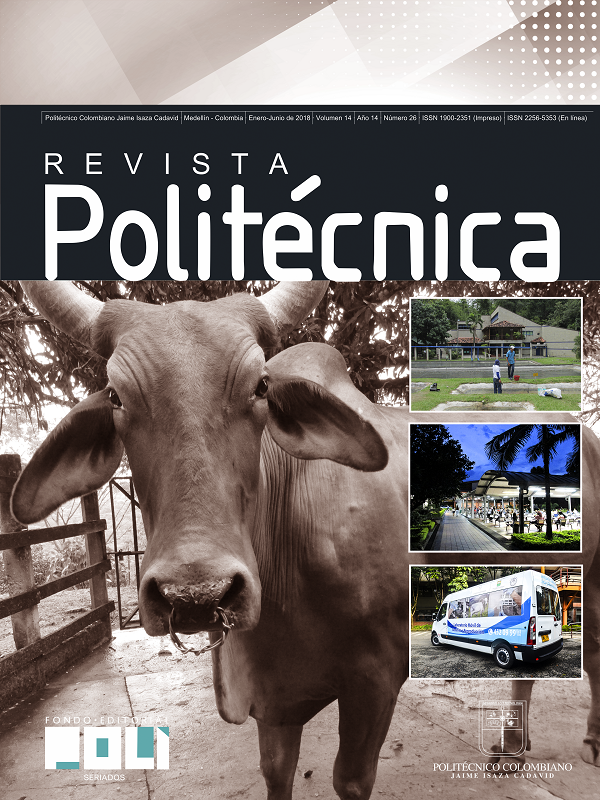Proposal of a procedure for automating an industrial process using Petri Nets as a formal tool
DOI:
https://doi.org/10.33571/rpolitec.v14n26a3Palabras clave:
automation project, formal methods, modeling, Petri nets.Resumen
Actualmente, los sistemas industriales deben adaptarse a los cambios de los mercados globalizados con elobjetivo de ser competitivos. En ese contexto, la automatización se presenta como unasolución paraasegurar la eficacia y eficiencia de la producción. Sin embargo, una correcta especificación de este tipo derespuesta no es tarea trivial. Esto debido tanto al incremento en las dinámicas de los procesos queinvolucran personal y recursos técnicos de diferente naturaleza como a los riegos derivados de unaincorrecta definición de la solución. Así, esteartículopresenta un proceso estructurado que considera lassemánticas de UML, Redes dePetri y EIC 1131 como herramientas de modelado para definir losrequerimientos, el comportamiento y la implementación del proyecto de automatización del sistema,respectivamente. Con el objetivo de valorar el abordaje propuesto, un ejemplo de aplicación fue desarrollado.Finalmente, son enunciadas las contribuciones relevantes en el contexto de la aplicación.Métricas de artículo
Resumen: 588 HTML (English): 103 PDF (English): 353 XML (English): 35Métricas PlumX
Citas
D. H. Autor, "Why Are There Still So Many Jobs? The History and Future of Workplace Automation," J. Econ. Perspect., vol. 29, no. 3, pp. 3–30, 2015.
D. T. Matt, E. Rauch, and P. Dallasega, "Trends towards distributed manufacturing systems and modern forms for their design," Procedia CIRP, vol. 33, pp. 185–190, 2015.
M. Rihar and G. Godena, "Automation of specification process for PLC control systemsnsoftware," 1999 7th IEEE Int. Conf. Emerg. Technol. Fact. Autom. Proc. ETFA ’99 (Cat. No.99TH8467), vol. 2, pp. 1289–1294, 1999.
M. Liukkonen, "RFID technology in manufacturing and supply chain," Int. J. Comput. Integr. Manuf., vol. 28, no. 8, pp. 861–880, 2015.
M. Hincapié, M. de Jesús Ramírez, A. Valenzuela, and J. A. Valdez, "Mixing real and virtual components in automated manufacturing systems using PLM tools," Int. J. Interact. Des. Manuf., vol. 8, no. 3, pp. 209–230, 2014.
R. Bayindir and Y. Cetinceviz, "A water pumping control system with a programmable logic controller (PLC) and industrial wireless modules for industrial plants-An experimental setup," ISA Trans., vol. 50, no. 2, pp. 321–328, 2011.
G. Frey, "Automatic implementation of Petri net based control algorithms on PLC," American Control Conference, 2000. Proceedings of the 2000, vol. 4. pp. 2819–2823 vol.4, 2000.
J. Luo, Q. Zhang, X. Chen, and M. Zhou, "Modeling and Race Detection of Ladder Diagrams via Ordinary Petri Nets," pp. 1–11, 2017.
M. Markiewicz and L. Gniewek, "A Program Model of Fuzzy Interpreted Petri Net to Control Discrete Event Systems," Appl. Sci., vol. 7, no. 4, p. 422, 2017.
L. Bryan and E. Bryan, "Chapter 10 The IEC 1131 Standard and Programming Language," in Programmable Controllers Theory Andimplementation, 2nd ed., Industrial Text Company, 1988.
P. Bonfatti, D. Monari, and U. Sampieri, IEC 1131-3 programming methodology. Software engineering methods for industrial automated systems. 1997.
T. Murata, "Petri nets: Properties, analysis and applications," Proc. IEEE, vol. 77, no. 4, pp. 541–580, Apr. 1989.
R. David and H. Alla, "Bases of Petri Nets," in Discrete, Continuous, and Hybrid Petri Nets SE - 1, Springer Berlin Heidelberg, 2010, pp. 1–20.
J. Dick, E. Hull, and K. Jackson, Requirements engineering. Springer, 2017.
J. Dick, E. Hull, and K. Jackson, "Requirements Engineering in the Problem Domain," in Requirements Engineering, Springer, 2017, pp. 113–134.
W. Chapman, Engineering modeling and design. Routledge, 2018.
L. E. G. Martins and T. Gorschek, "Requirements Engineering for Safety-Critical Systems: Overview and Challenges," IEEE Softw., vol. 34, no. 4, pp. 49–57, 2017.
J. S. Anderson and B. Durney, "Using scenarios in deficiency-driven requirements engineering," [1993] Proc. IEEE Int. Symp. Requir. Eng., pp. 134–141, 1992.
A. Arrieta, G. Sagardui, L. Etxeberria, and J. Zander, "Automatic generation of test system instances for configurable cyber-physical systems," Softw. Qual. J., vol. 25, no. 3, pp. 1041–1083, 2017.
P. H. Foo and G. W. Ng, "High-level Information Fusion : An Overview," J. Adv. Inf. Fusion, vol. 8, no. June, pp. 5–28, 2013.
"Use Case Diagram - UML 2 Diagrams - UML Modeling Tool." [Online]. Available: http://www.visual-paradigm.com/VPGallery/diagrams/UseCase.html#actor. [Accessed: 14-Jul-2014].
U. D. E. C. Station, "IDEF Family of Methods A Structured Approach to Enterprise Modeling & Analysis," Idef0 Method report, 2010. [Online]. Available: http://www.idef.com/. [Accessed: 20-Mar-2014].
A. A. V. Maobe, "System failure and perceived quality of services: a case of equity bank," 2014.
R. Sammi, I. Rubab, and M. A. Qureshi, "Formal specification languages for real-time systems," Proc. 2010 Int. Symp. Inf. Technol. - Syst. Dev. Appl. Knowl. Soc. ITSim’10, vol. 3, pp. 1642–1647, 2010.
G. Frey, "PLC Programming for Hybrid Systems via Signal Interpreted Petri Nets," Proc. 4th Int. Conf. Autom. Mix. Process. ADPM, pp. 189–194, 2000.
M. Ahmed, "A Comparative Analysis of Formal languages Based upon Various Parameters," vol. 3, no. February, pp. 434–438, 2016.
S. Rösch, S. Ulewicz, J. Provost, and B. Vogel-Heuser, "Review of Model-Based Testing Approaches in Production Automation and Adjacent Domains-Current Challenges and Research Gaps," J. Softw. Eng. Appl., vol. 8, no. 9, pp. 499–519, 2015.
P. Godefroid, Tests and Proofs, vol. 6706. 2011.
D. M. Uede and W. D. Miller, The engineering design of systems: models and methods. John Wiley & Sons, 2016.


 _
_






















